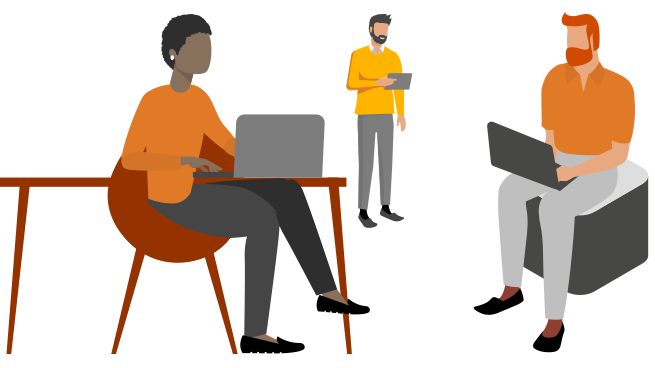
Mergers and acquisitions present companies with the opportunity to rethink the current setup of customer-facing teams. Often, a cultural and operating shift is necessary to increase customer centricity. In this case study we show you how we helped our client improve employee productivity, streamline customer experience, and increase revenue growth.
Situation
Over the years, our client, a globally operating industrial products company, made several strategic acquisitions. This led to the distinct challenge of integrating these businesses and to organically grow revenue. Leveraging the opportunities that were created by the joining of new companies was especially difficult for all the customer facing teams including marketing, sales, customer support and even field service. The teams were not only structurally siloed from each other and part of different subsidiary companies, but were also using different customer relationship management tools.
As part of its growth strategy, the global fire and security products and services company decided to address this Gordian knot by transforming from a diversified holding company to a streamlined operating company. Our client wanted to reconnect marketing, sales, field service operations and customer support to create a seamless customer experience and to drive commercial excellence. Harnessing the millions of customer touchpoints every week and adopting a centralised view were important aspects to achieve that goal. Before the firm embarked on this new journey, a single customer, for example, may have had several conversations with different company representatives throughout the week. This led to a disjointed consumer experience and made the need for developing a clear understanding of customer accounts obvious.

Webinar Series about Customer Centric Transformations
Whatever industry you operate in, now’s the time to take bold steps forward to get closer to your customers.
Our series of webinars is a chance for you to explore the latest trends in customer centric transformation and see how they might help you get closer to your target audience.
Approach
Due to our client’s global organisational setup and the implication transformations have on processes as well as workforce, it was clear that management buy-in and the support of both global and local level were crucial. At the same time, it was evident that to make these changes successful and sustainable, complexity had to be reduced and collaboration fostered.
Together with our client we defined the benefits of the new customer centric setup for the different functions and we formulated a set of desired outcomes in clear, multi-year business case. This step was key in getting senior leadership on board.
- Reduction of customer lead time
- Increase of qualified leads
- Increase of cross-selling activities
- Increase of renewal rate
Equally important to this shared notion of desired outcomes was that the transformation was business-led. By involving global sales as co-leader of the project, they were able to design and co-create important tools such as a globally aligned, standard business process from end-to-end. This involvement provided a translational layer between the different workstreams, which had a positive impact on the design, building and implementation of the program.
Solution
One of the main objectives of the transformation was to reduce complexity and to simplify processes. In order to create a connected ecosystem that delivers an exceptional customer experience, we removed legacy systems and introduced Salesforce to all business units. By migrating all existing data to Salesforce’s Marketing, Sales and Service Cloud, we were able to centralise marketing and sales activities. Creating such a repository created a single view of the customer.
At the beginning of our client’s journey, we helped design a global blueprint that defined standardised marketing, sales, and service processes. This so-called Global Template also outlined data and reporting standards, defined a standard terminology across commercial processes and technology, documented Salesforce configuration standards and established a set of KPIs that were tied to the business case.
Integrating the field service team and creating a single ecosystem that was shared with sales and marketing was an important step to pave the way for an individual end-to-end customer experience across all touchpoints.
With big changes to the way marketing, sales, and services are operating, pushback can occur. To mitigate this challenge, we set up a social contract. The goal was to obtain approval on the Global Template across all business units and regions in order to foster accountability. The respective leaders could approve the blueprint, propose amendments and provide feedback, but it wasn’t possible to opt out. Consequently, this strengthened collaboration between sales, marketing, field service, and customer support. They had to discuss and mutually agree upon important details such as the criteria that needed to be fulfilled to move a lead along the sales process. Importantly, the Global Template was designed to evolve over the course of the project and complemented the introduction of Salesforce.
Change management
At the outset of the project, we placed a strong focus on change management. Cultural change was needed throughout the company to drive transformation and to ensure its lasting success. New capabilities had to be built up in over twenty countries, the Salesforce solution had to be deployed to over 25,000 employees, and an agile way of working had to be introduced. Our playbook combined elements such as internal stakeholder assessment, the development of an adoption plan and a training strategy that included gamified training to upskill employees.
For the implementation, we chose a staggered approach with several go-lives. This allowed us to make important changes to processes, governance and change program during each roll out phase.
Result
The journey from vision through deployment took about two years. We were able to drastically increase both employee satisfaction and productivity. And we were well ahead of hitting targets that included an almost USD 1 billion incremental revenue increase over five years:
- 2-5% cost reduction across business units and regions
- 4-9% revenue increase across business units and regions
The alignment of marketing, sales, field service, and customer support in one centralised ecosystem led to smarter and faster customer care. The teams had a better understanding of their customers and their end-to-end journeys. As a consequence of introducing the Global Template and automated workflows, errors could be reduced and data quality improved. The cultural change that was set in motion at the global industrial products company allowed our client to harness the potential of the new, connected customer ecosystem by adopting an agile way of working focused on continuous improvement.
On a technical level, we were able to make the move from different customer relationship management tools to one, greatly reducing complexity and process variations, while ensuring scalability:
- Consolidated from five instances of Salesforce to one
- Reduced the number of Salesforce objects from over 150 to under 15
- Simplified the user interface: from 53 custom tabs to one and from almost 150 visualforce pages to less than five
This streamlining allowed our client to reduce maintenance costs, improve reporting and to convert data more effectively into actionable insights.
Ready to unlock your growth potential too? Get in touch to start a conversation.
https://pages.pwc.ch/core-contact-page?form_id=7014L000000Pp8ZQAS&embed=true&lang=en
Contact our experts
Lingli He







